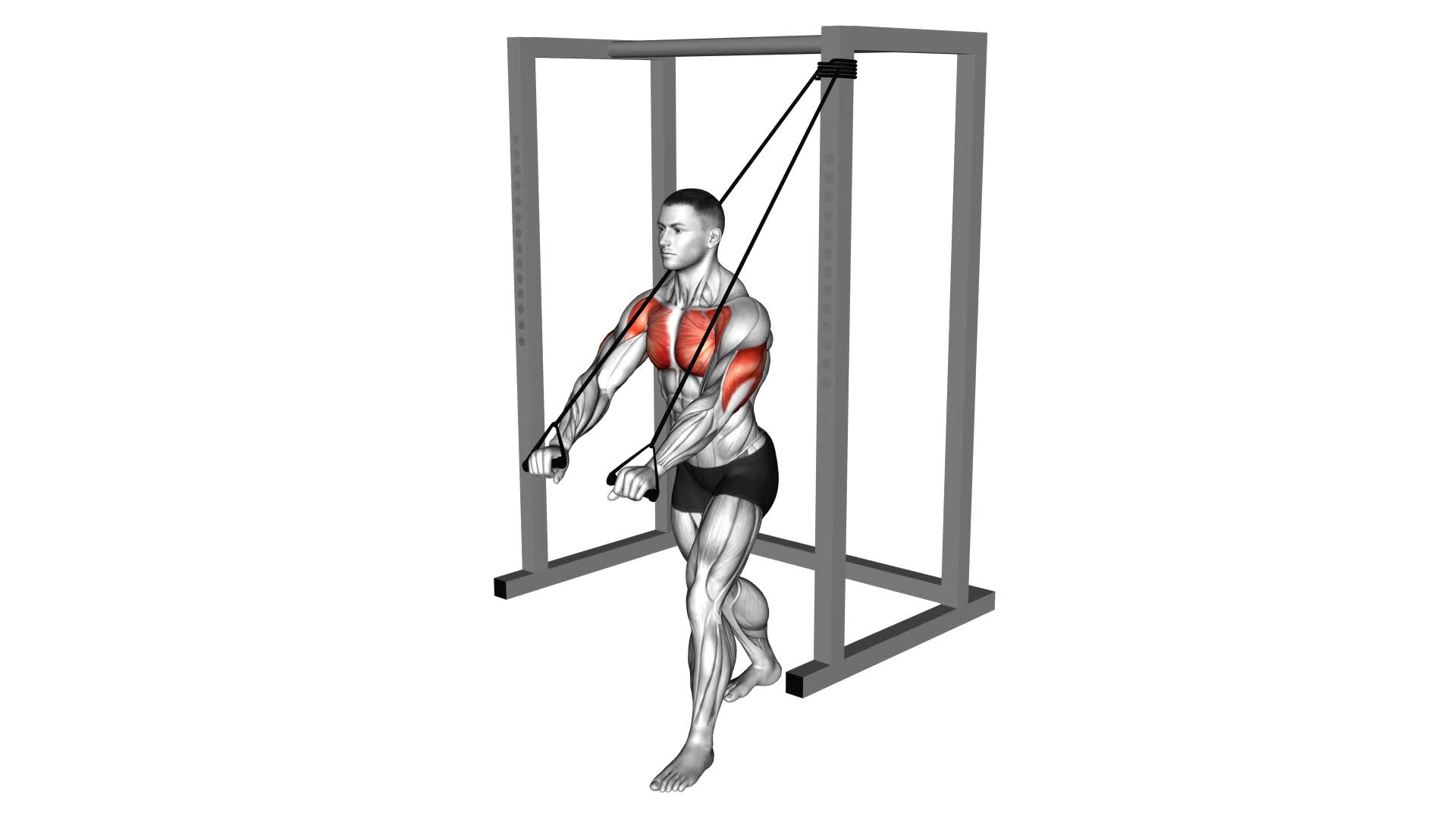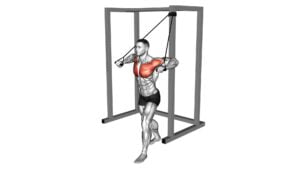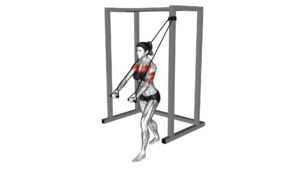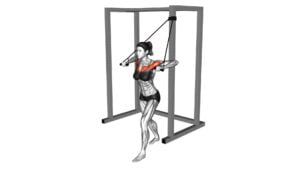Band Low Chest Press (male) – Video Exercise Guide & Tips

Get ready to strengthen and tone your chest with the band low chest press.
Watch This Exercise Video
In this video exercise guide, we'll show you the proper technique and form for this effective exercise.
Whether you're a beginner or an experienced fitness enthusiast, we've got variations and modifications to suit your fitness level.
Avoid common mistakes and maximize the effectiveness of your workout with our helpful tips.
Let's get started and take your chest workout to the next level.
Key Takeaways
- The Band Low Chest Press effectively targets the chest muscles and increases muscle activation and strength development.
- It is a versatile exercise that can be done anywhere and provides adjustable resistance for progression.
- The exercise requires a resistance band of appropriate resistance level and a stable anchor point.
- Proper form and technique involve attaching the band to a secure anchor point, creating tension in the band, and maintaining proper elbow position throughout the movement.
Benefits of the Band Low Chest Press
You can experience significant gains in chest strength by incorporating the Band Low Chest Press into your workout routine. This exercise offers numerous benefits and advantages that make it a valuable addition to any chest training program.
One of the main benefits of the Band Low Chest Press is its ability to target the chest muscles effectively. The resistance provided by the bands allows for a full range of motion, ensuring that your chest muscles are engaged throughout the entire exercise. This can lead to increased muscle activation and overall strength development in the chest area.
Another advantage of the Band Low Chest Press is its versatility. The exercise can be performed anywhere, as long as you have access to resistance bands. This makes it a convenient option for those who prefer to work out at home or while traveling. Additionally, the bands can be easily adjusted to increase or decrease the level of resistance, allowing for progression as your strength improves.
Incorporating the Band Low Chest Press into your workout routine can help you achieve a stronger and more defined chest.
Now, let's move on to the equipment needed for this exercise.
Equipment Needed for the Exercise
To perform the Band Low Chest Press exercise, you'll need the following equipment. First and foremost, you'll need a resistance band. These bands come in different resistance levels, so make sure to choose one that suits your fitness level and goals. The bands are usually color-coded to indicate their resistance level, ranging from light to heavy.
In addition to the resistance band, you'll also need an anchor point. This can be a sturdy pole, a door anchor, or any other secure object that can hold the band in place. Ensure that the anchor point is stable and strong enough to withstand the tension created by the band.
If you don't have access to a resistance band or an anchor point, there are alternative exercises you can do to target your chest muscles. Some of these exercises include push-ups, dumbbell chest presses, or machine chest presses. These exercises can provide a similar stimulus to your chest muscles and help you achieve your fitness goals.
Remember to always consult with a fitness professional or trainer before starting any new exercise program. They can guide you in choosing the right equipment and exercises based on your individual needs and fitness level.
Proper Form and Technique for the Band Low Chest Press
To perform the Band Low Chest Press with proper form and technique, it's important to focus on maintaining a stable anchor point and using a resistance band appropriate for your fitness level and goals.
Here are some key tips to help you execute this exercise effectively:
- Start by attaching the resistance band to a secure anchor point at chest height. This could be a sturdy pole or doorframe.
- Stand facing away from the anchor point and hold the handles of the resistance band with your palms facing down.
- Take a step forward to create tension in the band, ensuring it's securely wrapped around your back.
- Position your feet shoulder-width apart and keep your core engaged for stability.
- Begin the exercise by pushing your hands forward, extending your arms in front of you while keeping a slight bend in your elbows.
- Focus on squeezing your chest muscles as you extend your arms, feeling the tension in the resistance band.
- Slowly return to the starting position, maintaining control throughout the movement.
- Repeat for the desired number of repetitions, making sure to maintain proper form and technique.
Variations and Modifications for Different Fitness Levels
There are various ways to modify the Band Low Chest Press exercise for individuals at different fitness levels.
If you're a beginner, you can start with a lighter resistance band or even use a towel instead. This will reduce the intensity of the exercise and allow you to focus on learning proper form and technique. As you progress, you can gradually increase the resistance of the band to challenge your muscles more.
For those at an intermediate fitness level, you can try performing the exercise with a wider or narrower grip. This will change the angle of the movement and target different muscles in your chest and arms. Additionally, you can experiment with using a single-arm press instead of both arms simultaneously, which will increase the demand on your core and stabilizer muscles.
If you're an advanced exerciser, you can incorporate more advanced techniques such as tempo variations or using a resistance band with handles. These progression options will further challenge your muscles and enhance muscle activation.
Common Mistakes to Avoid While Performing the Exercise
When performing the Band Low Chest Press, it's important to pay attention to your elbow position. Make sure to keep your elbows at a 90-degree angle throughout the exercise to effectively target your chest muscles.
Additionally, focus on your breathing technique by exhaling as you push the bands away and inhaling as you bring them back in.
Elbow Position Importance
You should always maintain proper elbow position while performing the Band Low Chest Press exercise. Proper elbow alignment is crucial for effective muscle activation and to minimize the risk of injury.
Here are some common mistakes to avoid regarding elbow position:
- Avoid locking your elbows at the top of the movement. Keeping a slight bend in your elbows ensures constant tension on your chest muscles.
- Don't let your elbows flare out to the sides. Keep them slightly tucked in towards your body to engage your chest muscles more effectively.
- Avoid allowing your elbows to drop too low. Keeping your elbows at or just below shoulder level helps maintain proper form and prevents strain on your shoulders.
Breathing Technique During Exercise
To optimize your performance and minimize the risk of mistakes, it's essential to focus on your breathing technique during the Band Low Chest Press exercise.
Proper breathing plays a crucial role in improving your performance and ensuring that you get the most out of this exercise.
First and foremost, remember to inhale during the eccentric phase (when you lower the bands) and exhale during the concentric phase (when you push the bands away from your chest).
This breathing pattern helps stabilize your core and provides the necessary oxygen to your muscles.
Avoid holding your breath or exhaling forcefully, as it can hinder your performance and lead to fatigue more quickly.
Tips for Maximizing the Effectiveness of the Band Low Chest Press
For optimal results, incorporate various resistance bands into your band low chest press routine. To maximize resistance and target your chest muscles effectively, here are some tips:
- Choose the right resistance bands: Select bands with different levels of tension to challenge your chest muscles at varying intensities. Start with lighter resistance and gradually increase as you build strength.
- Maintain proper form: Focus on proper technique to ensure you engage your chest muscles effectively. Keep your back straight, shoulders down and back, and core engaged throughout the exercise. Avoid using momentum or relying solely on your arms to perform the movement.
- Control the movement: Slowly lower the bands towards your chest, allowing your muscles to work against the resistance. Pause briefly at the bottom before pushing the bands back up, maintaining control throughout the entire range of motion.
Frequently Asked Questions
How Many Sets and Reps Should I Do for the Band Low Chest Press?
To progress in the band low chest press, you should start with a weight that challenges you but allows for proper form. Aim for 3 sets of 8-12 reps, gradually increasing the resistance as you get stronger.
Avoid common mistakes like using too much momentum or arching your back. Focus on maintaining control and engaging your chest muscles throughout the movement.
Remember to warm up properly and listen to your body to prevent injury.
Can I Use Dumbbells Instead of Resistance Bands for This Exercise?
Yes, you can use dumbbells as an alternative to resistance bands for the band low chest press exercise.
While resistance bands provide a different type of resistance, dumbbells can still effectively target your chest muscles.
Dumbbells offer the advantage of allowing you to increase the weight as you get stronger.
However, resistance bands have the added benefit of providing constant tension throughout the entire range of motion, which can help improve muscle activation.
Is the Band Low Chest Press Suitable for Beginners?
The band low chest press is a suitable exercise for beginners. It helps strengthen your chest muscles.
To perform it with proper form and technique, start by securing the resistance band around a stable object at chest height. Stand facing away from the anchor point and hold the handles by your sides. Then, push your hands forward, extending your arms in front of you.
To progress, gradually increase the resistance or try other chest exercises like push-ups or dumbbell chest presses.
Can I Perform the Band Low Chest Press Without a Spotter?
Yes, you can perform the band low chest press without a spotter. However, it's important to do it safely.
Make sure to choose a resistance band that's appropriate for your strength level. Keep your core engaged and maintain proper form throughout the exercise.
If you're concerned about performing this exercise without a spotter, there are alternative exercises you can do to target your chest, such as push-ups, dumbbell chest press, or machine chest press.
What Muscles Does the Band Low Chest Press Primarily Target?
The band low chest press primarily targets your chest muscles. Incorporating band resistance training for your chest muscles has many benefits, such as increased muscle activation and improved strength.
The band low chest press exercise can be performed in various variations, allowing you to target different areas of your chest. It's a great way to add variety to your chest workout and challenge your muscles in new ways.
Conclusion
The band low chest press is a highly effective exercise for targeting the chest muscles. By using resistance bands, you can challenge your muscles and improve your strength.
Remember to maintain proper form and technique to maximize the effectiveness of the exercise. With variations and modifications available, this exercise can be adapted to different fitness levels.
Avoid common mistakes and follow the tips provided to make the most out of your band low chest press workout.

Author
Years ago, the spark of my life’s passion ignited in my mind the moment I stepped into the local gym for the first time. The inaugural bead of perspiration, the initial endeavor, the very first surge of endorphins, and a sense of pride that washed over me post-workout marked the beginning of my deep-seated interest in strength sports, fitness, and sports nutrition. This very curiosity blossomed rapidly into a profound fascination, propelling me to earn a Master’s degree in Physical Education from the Academy of Physical Education in Krakow, followed by a Sports Manager diploma from the Jagiellonian University. My journey of growth led me to gain more specialized qualifications, such as being a certified personal trainer with a focus on sports dietetics, a lifeguard, and an instructor for wellness and corrective gymnastics. Theoretical knowledge paired seamlessly with practical experience, reinforcing my belief that the transformation of individuals under my guidance was also a reflection of my personal growth. This belief holds true even today. Each day, I strive to push the boundaries and explore new realms. These realms gently elevate me to greater heights. The unique combination of passion for my field and the continuous quest for growth fuels my drive to break new ground.







